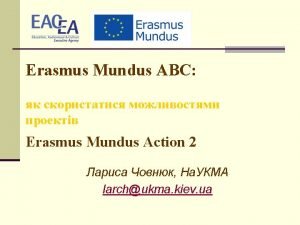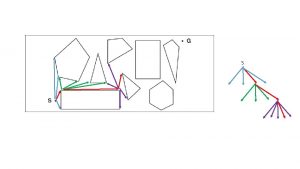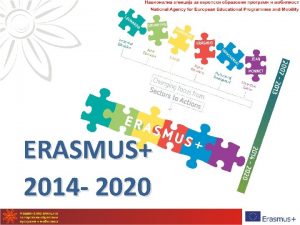PROGRAMME ERASMUS PROJECT ON THE MOVE IN EUROPE











- Slides: 11

PROGRAMME ERASMUS + PROJECT- , , ON THE MOVE IN EUROPE – TOWARDS A DEMOCRATIC MULTICULTURAL EUROPE” NR. 2016 -1 -DE 03 -KA 219 -022832_2 A BRIEF HISTORICAL PERSPECTIVE ON HUMAN MIGRATIONS IN ROMANIA National Pedagogical College “C. Bratescu” Constanta, Romania Igualada, Spain, March 2017

The history that has shaped Romania -the first tribes settled Romania has been inhabited they were Dacians; Herodotus called since the Paleolithic Age, as them "the fairest and most evidenced by carved stone tools courageous of men“, because they believed in the immortality of the unearthed there. soul and were not afraid to die. 3, 000 B. C. Thracian tribes of Indo-European origin, who migrated from Asia, occupied the actual territory of Romania. 2, 000 B. C. A distinctive Thracian subgroup emerged in what is now Romania. The Greeks called these people Getae, but to the Romans

Waves of Immigration Greeks arrived and settled colonies on the western coast of Black Sea 700 B. C. *Histria or Istros - the first urban settlement (“polis”) on Romanian territory; situated near the mouths of the Danube, the city went through Roman rule, until the invasions in 7 th century when was abandoned. *Tomis (or Tomi), the actual city of Constanta – was the second Greek colony on the Black Sea shore, founded for commercial exchanges with the local Getic populations; this is the city we come from. *Callatis – the actual city of Mangalia.

Waves of Immigration Romans colonize Dacia (modern-today Romania) 106 A. D After Dacian civilization reaches its peak, Romans conquer and colonize Dacia with an impresive number of colonists originarly from all the Empire and even Westrern Asia. So, Dacia becomes a province of the Roman Empire (106 -274 A. D). Dacians gradually adopt numerous elements of the conquerors' language. Tropaeum Traiani (monument in the honor of Emperor Trajan-in Adamclisi (55 km from Constanta, our city)

Waves of Immigration -The migrating peoples. Nomadic tribes from Asia and Europe (Goths, Visigoths, Huns, Slavs) invade Dacia 4 th to 9 th Centuries The Goths mixed with the local people until 4 th century, when a nomadic people, the Huns, arrived. The Gepids and the Avars and their Slavic subjects ruled Transylvania until 8 th century. The Pechenegs, the Cumans and Uzes were also mentioned by historic chronicles, until the founding of the Romanian principalities around 1300. Different migrating peoples lived alongside the local populations, such as: the Gothic Empire, from 271 -378, the Hunnish Empire- until 435, the Avar Empire and Slavs during the 6 th century.

Waves of Immigration Colonization of the Romanian territory 896 — late 1100 s Magyars (Hungarians) invade regions in western and central present-day Romania (Crisana, Banat and Transylvania) 12 th century- Saxon (German) settlers, brought by the king of Hungary, to consolidate his power, begin to establish several towns in Transylvania. *Szeklers people- descendants from Attila’s Huns- were also brought to eastern and southeastern Transylvania as border guards. Between 1000 - 1100 -Gypsies entered Romanian territory.

12 th century

Waves of Immigration Ottoman Empire expansion allowed Turkish traders to settle here, followed by the and Romanian Muslims Exod to Dobruja: The three Romanian provinces of Wallachia, Moldova and Transylvania have been under the suzerainty of the Turkish Ottoman Empire for couple of centuries, but they were able to retain their autonomy by paying tribute to the Turks. Northern Dobruja, a region on the Black Sea coast which was part of the Ottoman Empire for almost five centuries (1420 -1878) * Crimean Tatars took refuge in Dobruja 1783 * Circassians (200, 000), refugees from the Caucasian War, resettled in the Dobruja and northern Bulgaria by the Ottomans

Actual migrations in Romania 25 years Emigration The economic migrants have been oriented towards Spain, Italy, Germany, France, U. K. Economic migrants The most important reason why more than 1, 5 milion Romanians choose to migrate to another country is the economic one. Globalisation has increased the demand for workers from other countries in order to sustain national economies.

Romania, though not a very popular destination for immigrants, has recently experienced a growing wave of immigration, mostly from the * Republic of Moldova *Turkey *China *Africa *the Middle East *the former Soviet Union

Thank you for your attention! Authors: Prof. Dr. Popescu Polixenia Andoni Iliuta-Laurentiu Cristurean Cezar Vasile
 Co-funded by the erasmus+ programme of the european union
Co-funded by the erasmus+ programme of the european union Co-funded by the erasmus+ programme of the european union
Co-funded by the erasmus+ programme of the european union Co-funded by the erasmus+ programme of the european union
Co-funded by the erasmus+ programme of the european union Erasmus lifelong learning programme
Erasmus lifelong learning programme Lateral thinking brain teasers
Lateral thinking brain teasers Erasmus project results platform
Erasmus project results platform Hình ảnh bộ gõ cơ thể búng tay
Hình ảnh bộ gõ cơ thể búng tay Ng-html
Ng-html Bổ thể
Bổ thể Tỉ lệ cơ thể trẻ em
Tỉ lệ cơ thể trẻ em Voi kéo gỗ như thế nào
Voi kéo gỗ như thế nào Chụp tư thế worms-breton
Chụp tư thế worms-breton





















